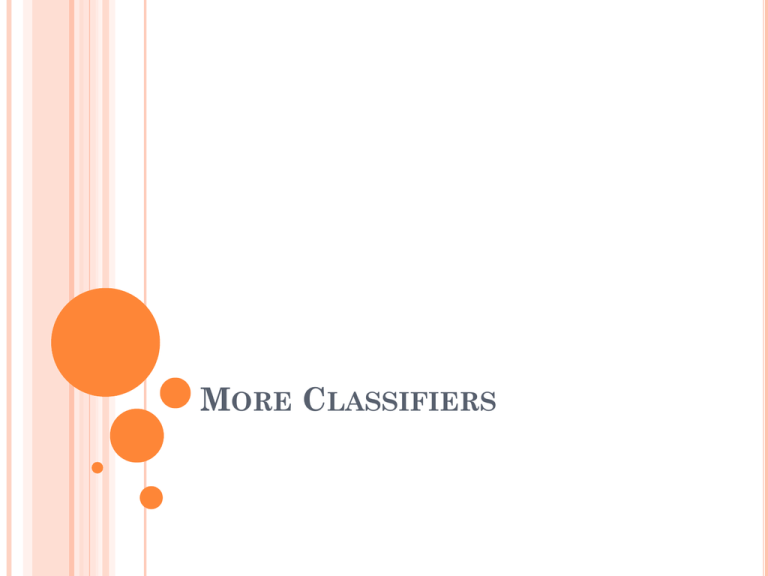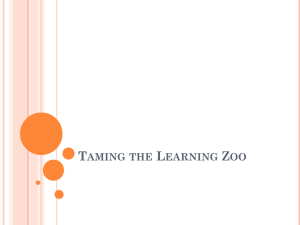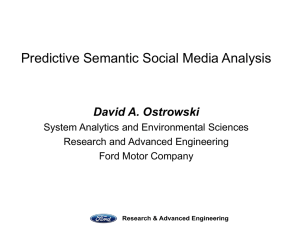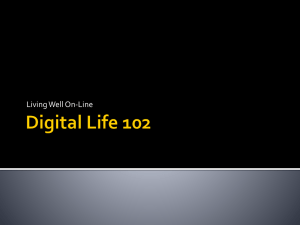Neural networks
advertisement

MORE CLASSIFIERS AGENDA Key concepts for all classifiers Precision vs recall Biased sample sets Linear classifiers Intro to neural networks RECAP: DECISION BOUNDARIES With continuous attributes, a decision boundary is the surface in example space that splits positive from negative examples x2 x1>=20 T x2>=10 F x2>=15 F T F T T F x1 BEYOND ERROR RATES 4 BEYOND ERROR RATE Predicting security risk Predicting “low risk” for a terrorist, is far worse than predicting “high risk” for an innocent bystander (but maybe not 5 million of them) Searching for images Returning irrelevant images is worse than omitting relevant ones 5 BIASED SAMPLE SETS Often there are orders of magnitude more negative examples than positive E.g., all images of Kris on Facebook If I classify all images as “not Kris” I’ll have >99.99% accuracy Examples of Kris should count much more than non-Kris! FALSE POSITIVES True decision boundary Learned decision boundary x2 x1 7 An example incorrectly predicted to be positive FALSE POSITIVES True decision boundary Learned decision boundary x2 New query x1 8 An example incorrectly predicted to be negative FALSE NEGATIVES True decision boundary Learned decision boundary x2 New query x1 9 PRECISION VS. RECALL Precision Recall # of relevant documents retrieved / # of total documents retrieved # of relevant documents retrieved / # of total relevant documents Numbers between 0 and 1 10 PRECISION VS. RECALL Precision # of true positives / (# true positives + # false positives) Recall # of true positives / (# true positives + # false negatives) A precise classifier is selective A classifier with high recall is inclusive 11 REDUCING FALSE POSITIVE RATE True decision boundary Learned decision boundary x2 x1 12 REDUCING FALSE NEGATIVE RATE True decision boundary Learned decision boundary x2 x1 13 PRECISION-RECALL CURVES Measure Precision vs Recall as the decision boundary is tuned Recall Perfect classifier Actual performance 14 Precision PRECISION-RECALL CURVES Measure Precision vs Recall as the decision boundary is tuned Recall Penalize false negatives Equal weight Penalize false positives 15 Precision PRECISION-RECALL CURVES Measure Precision vs Recall as the decision boundary is tuned Recall 16 Precision PRECISION-RECALL CURVES Measure Precision vs Recall as the decision boundary is tuned Recall Better learning performance 17 Precision OPTION 1: CLASSIFICATION THRESHOLDS Many learning algorithms (e.g., probabilistic models, linear models) give real-valued output v(x) that needs thresholding for classification v(x) > t => positive label given to x v(x) < t => negative label given to x May want to tune threshold to get fewer false positives or false negatives 18 OPTION 2: WEIGHTED DATASETS Weighted datasets: attach a weight w to each example to indicate how important it is Instead of counting “# of errors”, count “sum of weights of errors” Or construct a resampled dataset D’ where each example is duplicated proportionally to its w As the relative weights of positive vs negative examples is tuned from 0 to 1, the precisionrecall curve is traced out LINEAR CLASSIFIERS : MOTIVATION Decision tree produces axis-aligned decision boundaries Can we accurately classify data like this? x2 x1 PLANE GEOMETRY Any line in 2D can be expressed as the set of solutions (x,y) to the equation ax+by+c=0 (an implicit surface) ax+by+c > 0 is one side of the line ax+by+c < 0 is the other ax+by+c = 0 is the line itself y b a x PLANE GEOMETRY In 3D, a plane can be expressed as the set of solutions (x,y,z) to the equation ax+by+cz+d=0 ax+by+cz+d > 0 is one side of the plane ax+by+cz+d < 0 is the other side ax+by+cz+d = 0 is the plane itself z c a b x y LINEAR CLASSIFIER In d dimensions, c0+c1*x1+…+cd*xd =0 is a hyperplane. Idea: Use c0+c1*x1+…+cd*xd > 0 to denote positive classifications Use c0+c1*x1+…+cd*xd < 0 to denote negative classifications PERCEPTRON x2 + + x1 + - - + xi wi + S g xn y = f(x,w) = g(Si=1,…,n wi xi) y x1 - w1 x1 + w2 x2 = 0 - g(u) 24 u A SINGLE PERCEPTRON CAN LEARN x1 xi wi S g y xn A disjunction of boolean literals x1 x2 x3 Majority function 25 A SINGLE PERCEPTRON CAN LEARN x1 xi wi S g y xn A disjunction of boolean literals x1 x2 x3 Majority function XOR? 26 PERCEPTRON LEARNING RULE θ θ + x(i)(y(i)-g(θT x(i))) (g outputs either 0 or 1, y is either 0 or 1) If output is correct, weights are unchanged If g is 0 but y is 1, then the value of g on attribute i is increased If g is 1 but y is 0, then the value of g on attribute i is decreased Converges if data is linearly separable, but oscillates otherwise 27 PERCEPTRON + + x1 xi wi ? - S + g xn y = f(x,w) = g(Si=1,…,n wi xi) y - + + - g(u) 28 u UNIT (NEURON) x1 xi wi S g y xn y = g(Si=1,…,n wi xi) g(u) = 1/[1 + exp(-u)] 29 NEURAL NETWORK Network of interconnected neurons x1 xi w x1 i xi w i xn S g y S g y xn 30 Acyclic (feed-forward) vs. recurrent networks TWO-LAYER FEED-FORWARD NEURAL NETWORK w1j Inputs w2k Hidden layer Output layer 31 NETWORKS WITH HIDDEN LAYERS Can represent XORs, other nonlinear functions Common neuron types: Soft perceptron (sigmoid), radial basis functions, linear, … As the number of hidden units increase, so does the network’s capacity to learn functions with more nonlinear features How to train hidden layers? 32 BACKPROPAGATION (PRINCIPLE) Treat the problem as one of minimizing errors between the example label and the network output, given the example and network weights as input Sum this error term over all examples Error(xi,yi,w) = (yi – f(xi,w))2 E(w) = Si Error(xi,yi,w) = Si (yi – f(xi,w))2 Minimize errors using an optimization algorithm Stochastic gradient descent is typically used 33 Gradient direction 𝛻𝐸 is orthogonal to the level sets (contours) of E, points in direction of steepest increase Gradient direction 𝛻𝐸 is orthogonal to the level sets (contours) of E, points in direction of steepest increase Gradient descent: iteratively move in direction −𝛻E Gradient descent: iteratively move in direction −𝛻E Gradient descent: iteratively move in direction −𝛻E Gradient descent: iteratively move in direction −𝛻E Gradient descent: iteratively move in direction −𝛻E Gradient descent: iteratively move in direction −𝛻𝐸 Gradient descent: iteratively move in direction −𝛻𝐸 STOCHASTIC GRADIENT DESCENT For each example (xi,yi), take a gradient descent step to reduce the error for (xi,yi) only. 43 STOCHASTIC GRADIENT DESCENT Objective function values (measured over all examples) over time settle into local minimum Step size must be reduced over time, e.g., O(1/t) 44 NEURAL NETWORKS: PROS AND CONS Pros Bioinspiration is nifty Can represent a wide variety of decision boundaries Complexity is easily tunable (number of hidden nodes, topology) Easily extendable to regression tasks Cons Haven’t gotten close to unlocking the power of the human (or cat) brain Complex boundaries need lots of data Slow training Mostly lukewarm feelings in mainstream ML (although the “deep learning” variant is en vogue now) NEXT CLASS Another guest lecture







